Another alternative solution, where:
- states are represented as terms, and
- iterative deepening search is controled through the use of predicate
length/2.
With this implementation, a solution was found in approximately 40 seconds (SWI-Prolog, v.8.2.4).
ids :-
start(State),
length(Moves, N),
dfs([State], Moves, Path), !,
show([start|Moves], Path),
format('~nmoves = ~w~n', [N]).
dfs([State|States], [], Path) :-
goal(State), !,
reverse([State|States], Path).
dfs([State|States], [Move|Moves], Path) :-
move(State, Next, Move),
not(memberchk(Next, [State|States])),
dfs([Next,State|States], Moves, Path).
show([], _).
show([Move|Moves], [State|States]) :-
State = state(A,B,C,D,E,F,G,H,I),
format('~n~w~n~n', [Move]),
format('~w ~w ~w~n',[A,B,C]),
format('~w ~w ~w~n',[D,E,F]),
format('~w ~w ~w~n',[G,H,I]),
show(Moves, States).
% Empty position is marked with '*'
start( state(6,1,3,4,*,5,7,2,0) ).
goal( state(*,0,1,2,3,4,5,6,7) ).
move( state(*,B,C,D,E,F,G,H,J), state(B,*,C,D,E,F,G,H,J), right).
move( state(*,B,C,D,E,F,G,H,J), state(D,B,C,*,E,F,G,H,J), down ).
move( state(A,*,C,D,E,F,G,H,J), state(*,A,C,D,E,F,G,H,J), left ).
move( state(A,*,C,D,E,F,G,H,J), state(A,C,*,D,E,F,G,H,J), right).
move( state(A,*,C,D,E,F,G,H,J), state(A,E,C,D,*,F,G,H,J), down ).
move( state(A,B,*,D,E,F,G,H,J), state(A,*,B,D,E,F,G,H,J), left ).
move( state(A,B,*,D,E,F,G,H,J), state(A,B,F,D,E,*,G,H,J), down ).
move( state(A,B,C,*,E,F,G,H,J), state(*,B,C,A,E,F,G,H,J), up ).
move( state(A,B,C,*,E,F,G,H,J), state(A,B,C,E,*,F,G,H,J), right).
move( state(A,B,C,*,E,F,G,H,J), state(A,B,C,G,E,F,*,H,J), down ).
move( state(A,B,C,D,*,F,G,H,J), state(A,*,C,D,B,F,G,H,J), up ).
move( state(A,B,C,D,*,F,G,H,J), state(A,B,C,D,F,*,G,H,J), right).
move( state(A,B,C,D,*,F,G,H,J), state(A,B,C,D,H,F,G,*,J), down ).
move( state(A,B,C,D,*,F,G,H,J), state(A,B,C,*,D,F,G,H,J), left ).
move( state(A,B,C,D,E,*,G,H,J), state(A,B,*,D,E,C,G,H,J), up ).
move( state(A,B,C,D,E,*,G,H,J), state(A,B,C,D,*,E,G,H,J), left ).
move( state(A,B,C,D,E,*,G,H,J), state(A,B,C,D,E,J,G,H,*), down ).
move( state(A,B,C,D,E,F,*,H,J), state(A,B,C,D,E,F,H,*,J), left ).
move( state(A,B,C,D,E,F,*,H,J), state(A,B,C,*,E,F,D,H,J), up ).
move( state(A,B,C,D,E,F,G,*,J), state(A,B,C,D,E,F,*,G,J), left ).
move( state(A,B,C,D,E,F,G,*,J), state(A,B,C,D,*,F,G,E,J), up ).
move( state(A,B,C,D,E,F,G,*,J), state(A,B,C,D,E,F,G,J,*), right).
move( state(A,B,C,D,E,F,G,H,*), state(A,B,C,D,E,*,G,H,F), up ).
move( state(A,B,C,D,E,F,G,H,*), state(A,B,C,D,E,F,G,*,H), left ).
Running example:
?- time(ids).
start
6 1 3
4 * 5
7 2 0
left
6 1 3
* 4 5
7 2 0
up
* 1 3
6 4 5
7 2 0
right
1 * 3
6 4 5
7 2 0
down
1 4 3
6 * 5
7 2 0
right
1 4 3
6 5 *
7 2 0
down
1 4 3
6 5 0
7 2 *
left
1 4 3
6 5 0
7 * 2
left
1 4 3
6 5 0
* 7 2
up
1 4 3
* 5 0
6 7 2
right
1 4 3
5 * 0
6 7 2
right
1 4 3
5 0 *
6 7 2
down
1 4 3
5 0 2
6 7 *
left
1 4 3
5 0 2
6 * 7
left
1 4 3
5 0 2
* 6 7
up
1 4 3
* 0 2
5 6 7
right
1 4 3
0 * 2
5 6 7
right
1 4 3
0 2 *
5 6 7
up
1 4 *
0 2 3
5 6 7
left
1 * 4
0 2 3
5 6 7
left
* 1 4
0 2 3
5 6 7
down
0 1 4
* 2 3
5 6 7
right
0 1 4
2 * 3
5 6 7
right
0 1 4
2 3 *
5 6 7
up
0 1 *
2 3 4
5 6 7
left
0 * 1
2 3 4
5 6 7
left
* 0 1
2 3 4
5 6 7
moves = 26
% 97,719,612 inferences, 40.344 CPU in 40.991 seconds (98% CPU, 2422175 Lips)
true.
